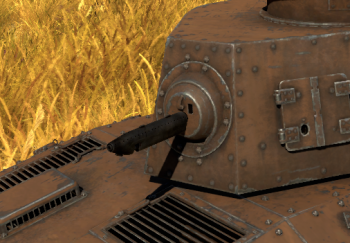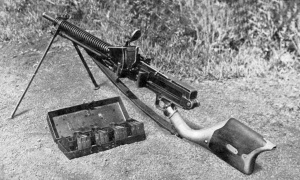Type 91 (6.5 mm)
Contents
Description
The Type 91 machine gun is a Type 11 light machine gun which was modified to be mounted in tanks and other armoured vehicles. Modifications included removal of stock and bi-pod and the addition of an angled pistol grip and brackets for mounting a 1.5x30 scope.
Vehicles equipped with this weapon
General info
The main doctrine of Japanese machine guns is more towards accuracy and mid-to-long range infantry engagement and hence the lower fire-rate and small clip-size.
In-game, the only Type 91 is usable on the Type 89 I-Go with the only working MG mounted in the hull, which can pretty much only be used for spotting on the map in RB or with very occasional unarmoured vehicles with unprotected crew such as on trucks.
Available ammunition
- Default: Ball · T
| Penetration statistics | ||||||
|---|---|---|---|---|---|---|
| Belt | Penetration @ 0° Angle of Attack (mm) | |||||
| 10 m | 100 m | 500 m | 1,000 m | 1,500 m | 2,000 m | |
| Default | 5 | 4 | 2 | 1 | 0 | 0 |
Comparison with analogues
Give a comparative description of cannons/machine guns that have firepower equal to this weapon.
Usage in battles
Describe the cannon/machine gun in the game - its distinctive features, tactics of usage against notable opponents. Please don't write a "guide" - do not impose a single point of view, but give the reader food for thought.
Pros and cons
Summarise and briefly evaluate the weaponry in terms of its characteristics and combat effectiveness. Mark pros and cons as a list.
Pros:
Cons:
History
The Type 11 machine gun, developed by General Kijiro Nambu, was Japan's second domestically produced machine gun and adopted in 1922. The Type 11 was based of General Nambu's previous work, the Type 3 machine gun adopted in 1914. Its designation come from its year of adoption in the 11th year of the reign of Emperor Taisho (1922).[1]
The Type 11 is notable for its unusual loading mechanism using a clip-fed hopper to load 6.5x50 mmSR ammunition in stripper clips, the hopper holding six clips at a time. This ideally allows the machine gunner's assistant to continually top off the weapon with stripper clips while the gunner fires the weapon. This system also allows the machine gun team to utilize the ammunition set used by the standard rifleman. The weapon was also relatively lightweight at 10.2 kg (~22.5 lb)[2]
However, the weapon had problematic design issues that plagued its full potential. The barrel was not easily changeable, requiring essentially a full disassembly of the weapon's receiver before being able to detach the barrel.[2] This restricted the weapon's ability to perform sustained fire. The weapon also had no primary extractor which could cause issue with the extraction of spent ammo casings. In an attempt to solve this issue, a small oil injector was installed into the machine to lubricate the cartridge prior to being fed into the gun. However, the lubricant tended to attract dirt and dust, which could also cause stoppages and jams.[3]
The machine gun saw service in the Soviets-Japanese border conflicts of 1938-1939, with an assortment of Japanese weapons falling into Soviet hands, who praised the hopper's logistical fitting with a rifleman's ammunition supply, but criticized the weapon's ergonomics for barrel changing and the complicated nature of the hopper feed. The weapon still made a favourable enough impression for the Soviets to attempt a version of the hopper feed in their own DP-27 machine gun.[4]
The Type 91 was a tank-mounted variant of the Type 11, notable by its larger hopper design to fit ten clips at a time rather than the standard six. The weapon was typically mounted with a low magnification telescopic sight. However, the weapons still suffered issues that the infantry version has and so was later replaced by the Type 97 tank machine gun.[1]
Media
Excellent additions to the article would be video guides, screenshots from the game, and photos.
See also
Links to the articles on the War Thunder Wiki that you think will be useful for the reader, for example:
- reference to the article about the variant of the cannon/machine gun;
- references to approximate analogues by other nations and research trees.
External links
References
- Citations
- Bibliography
- Popenker, Maxim and Anthony G Williams. 2008. Machine Gun: The Development of the Machine Gun from the Nineteenth Century to the Present Day. Marlborough: The Crowood Press Ltd.
- McCollum, Ian. 2012. "Type 11 Nambu LMG." Forgotten Weapons. Last modified March 30, 2012. Website (Archive).
| Tank machine guns | |
|---|---|
| USA | |
| 7.62 mm | M37 · M60D · M73 · M240 · M1919A4 |
| 12.7 mm | FN M3P · M2HB · M80 · M85 |
| Germany | |
| 5.56 mm | MG4 |
| 7.62 mm | C6 · MG3A1 |
| 7.92 mm | MG13 Dreyse · MG34 · MG37(t) · MG42 |
| 12.7 mm | S.MG.50 |
| USSR | |
| 7.62 mm | DT · PKMB · PKT · PKTM · RP-46 · SGMT |
| 12.7 mm | DK · DShK · 6P49 · NSVT |
| 14.5 mm | KPVT |
| Britain | |
| 7.62 mm | Browning MG4 · L3A1 · L8A1 · L8A2 · L37A1 · L37A2 · L94A1 |
| 7.7 mm | Vickers |
| 7.92 mm | BESA |
| 12.7 mm | L21A1 |
| Japan | |
| 6.5 mm | Type 91 |
| 7.62 mm | Type 74 |
| 7.7 mm | Type 97 |
| 12.7 mm | Type 60 (B) |
| China | |
| 5.8 mm | QJT |
| 7.62 mm | Type 55 · Type 59 · Type 86 |
| 12.7 mm | QJC88A · Type 54 |
| 14.5 mm | QJG02 |
| Italy | |
| 7.62 mm | Beretta MG42/59 · FN MAG 60-40 |
| 8 mm | 34/40M · Breda Mod. 38 |
| 13.2 mm | Breda Model 31 |
| France | |
| 7.5 mm | AAT-52 · MAC 31 |
| 7.62 mm | A-A-F1N |
| 8 mm | Hotchkiss Mle 1914 |
| Sweden | |
| 6.5 mm | ksp m/14-29 |
| 7.62 mm | ksp 39 C · ksp 58 · ksp 94 |
| 8 mm | ksp m/36 · ksp m/39B |
| 12.7 mm | ksp 88 |





